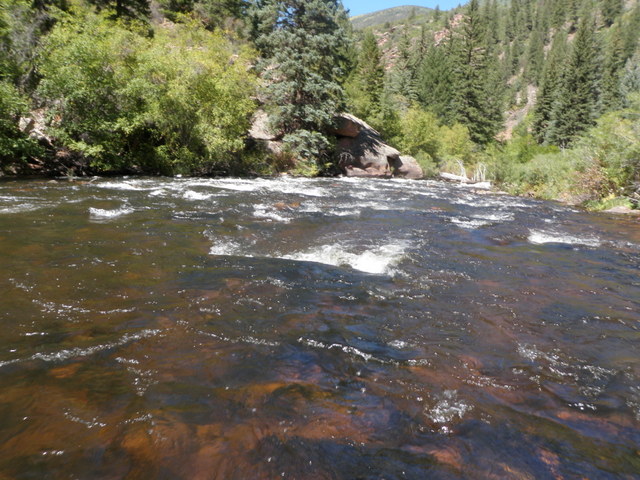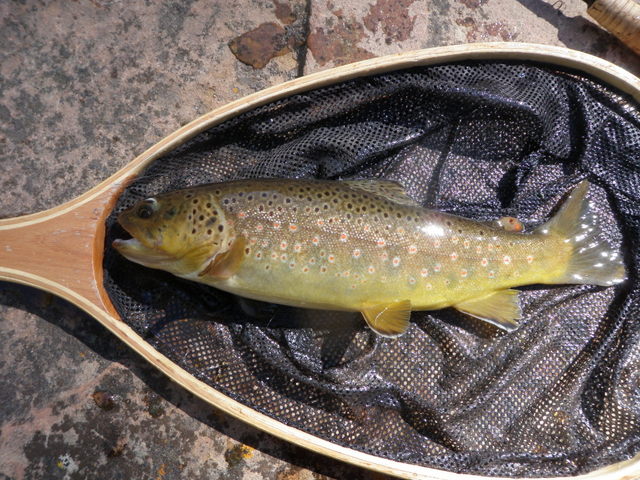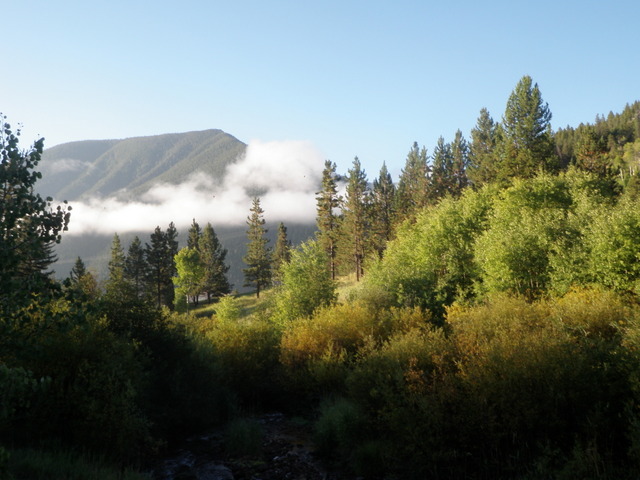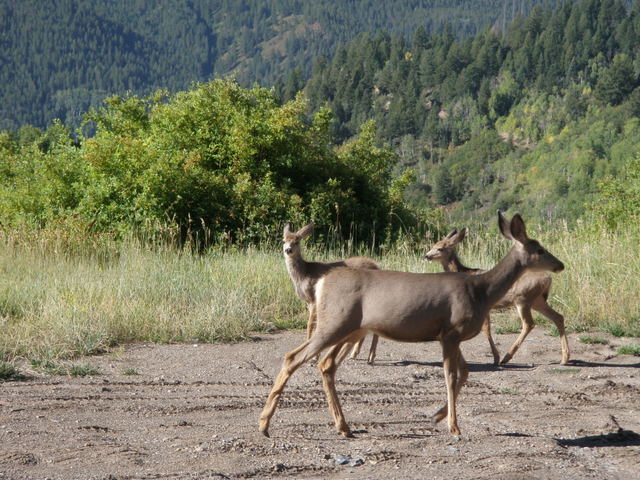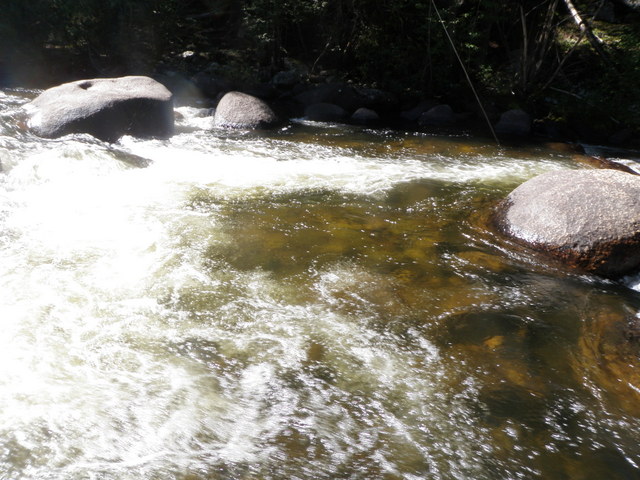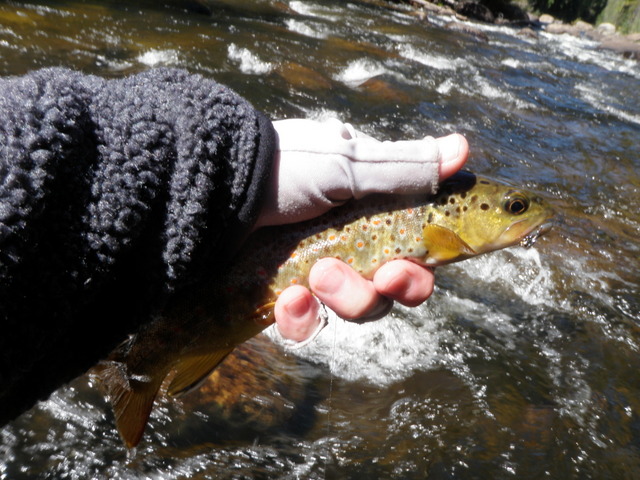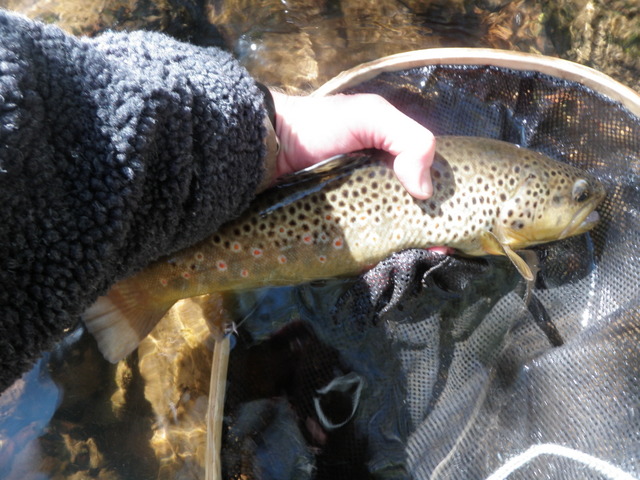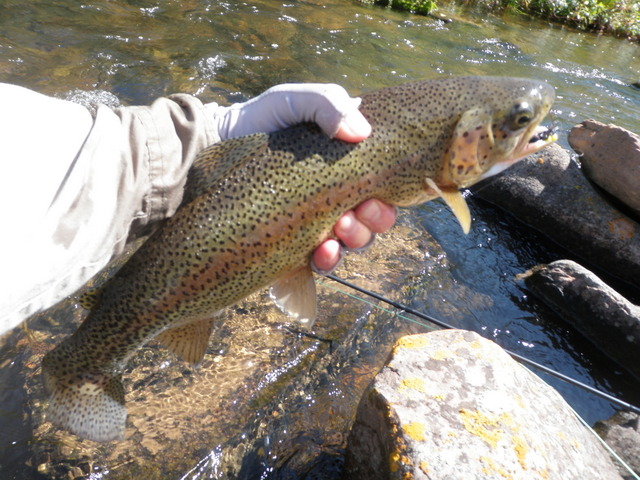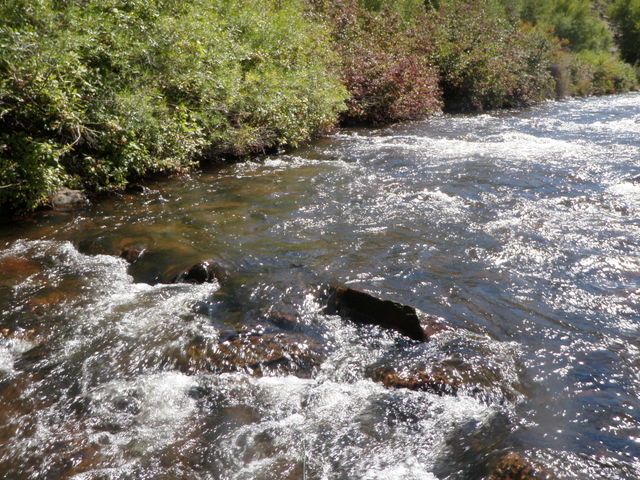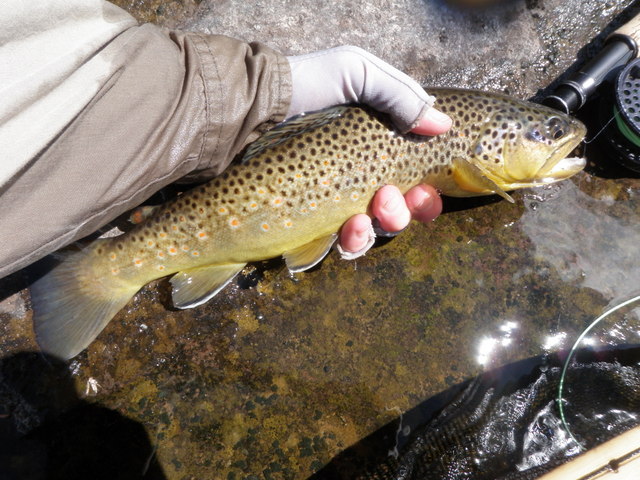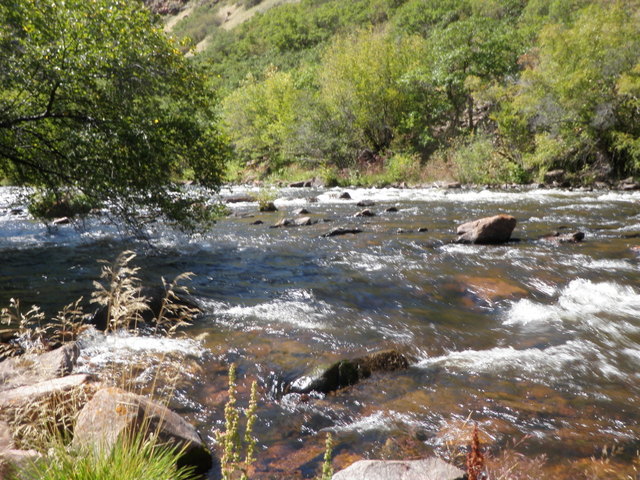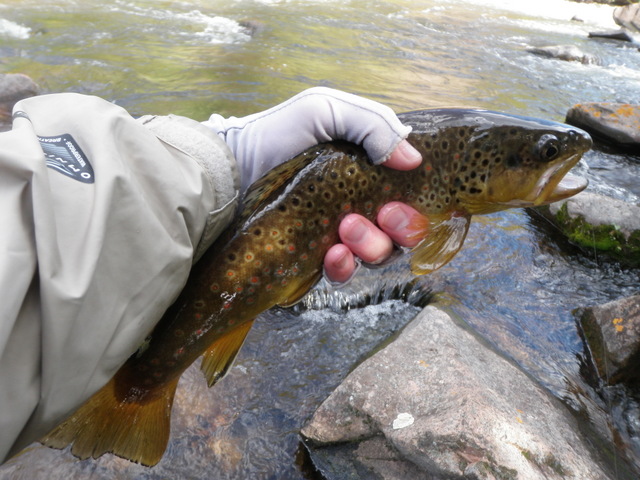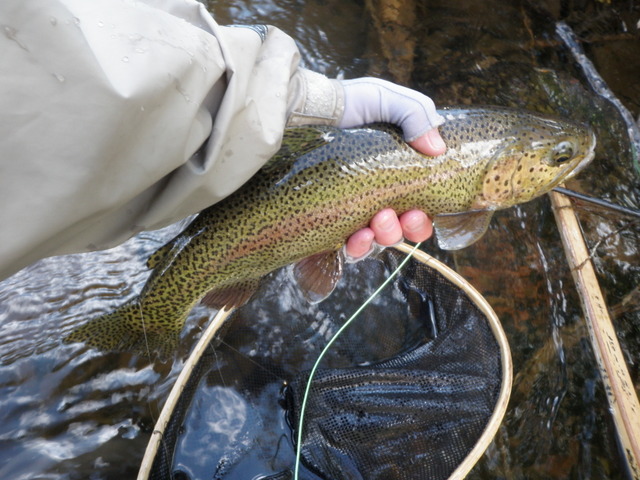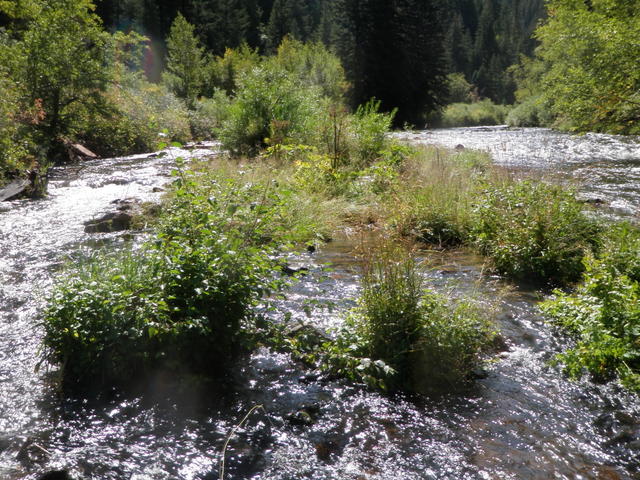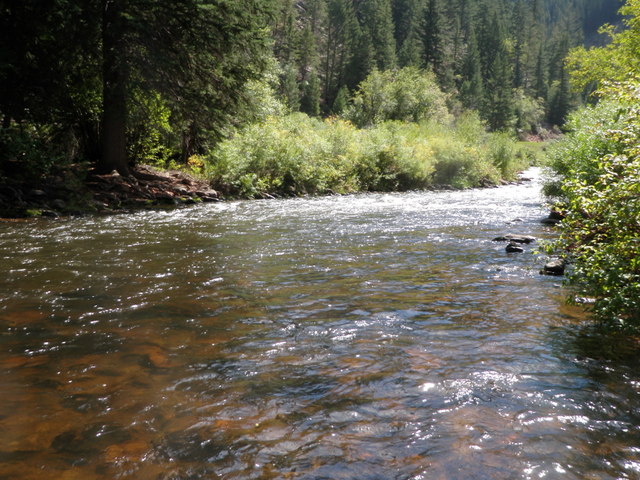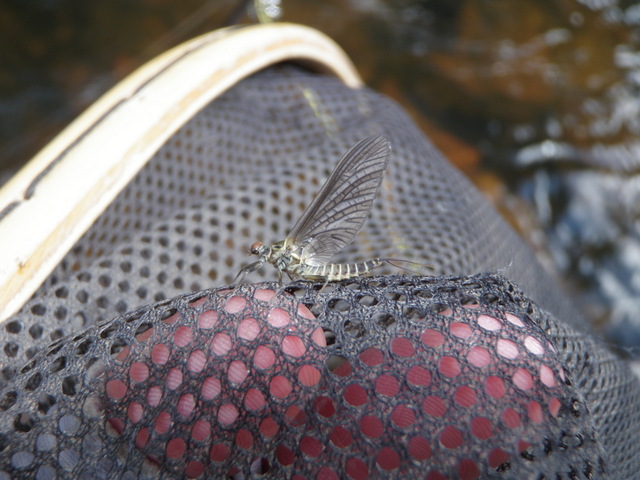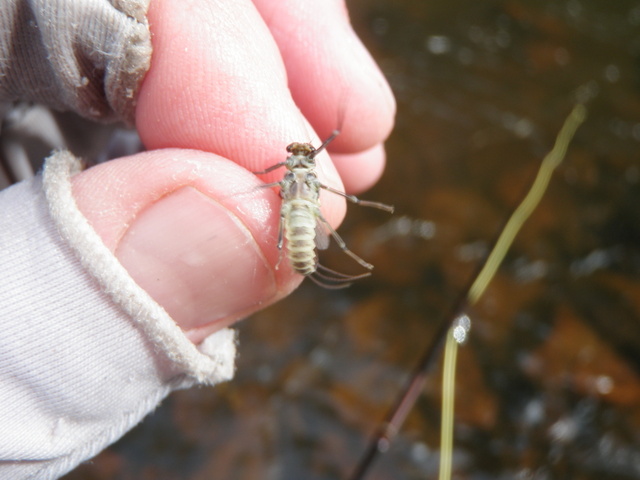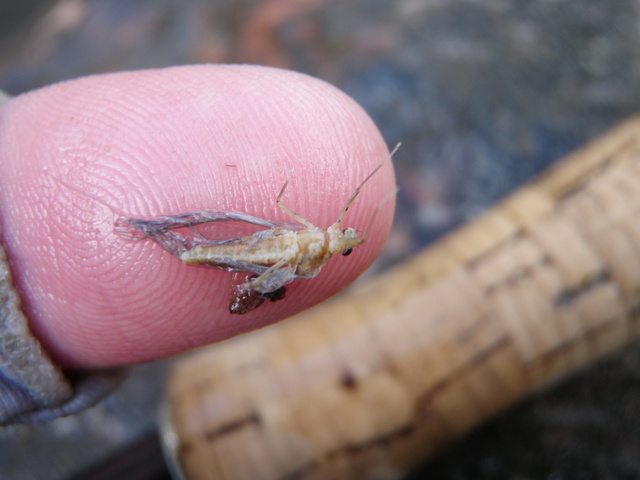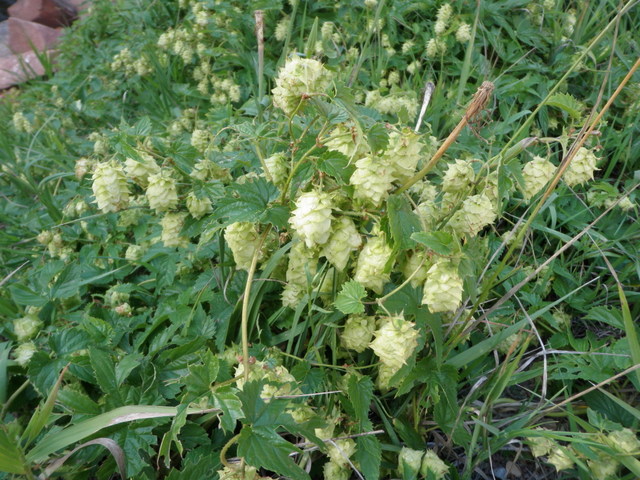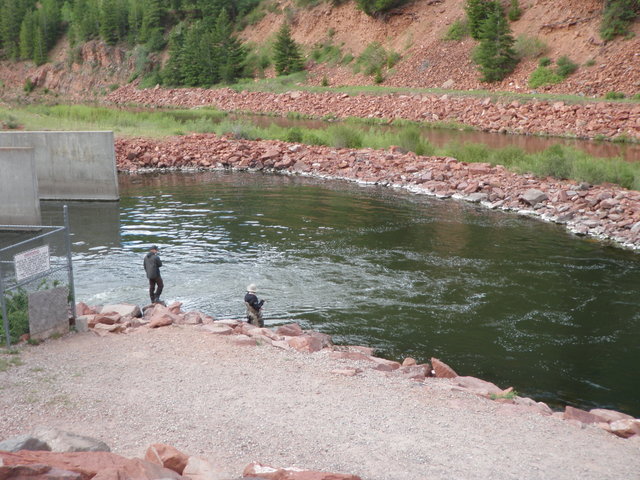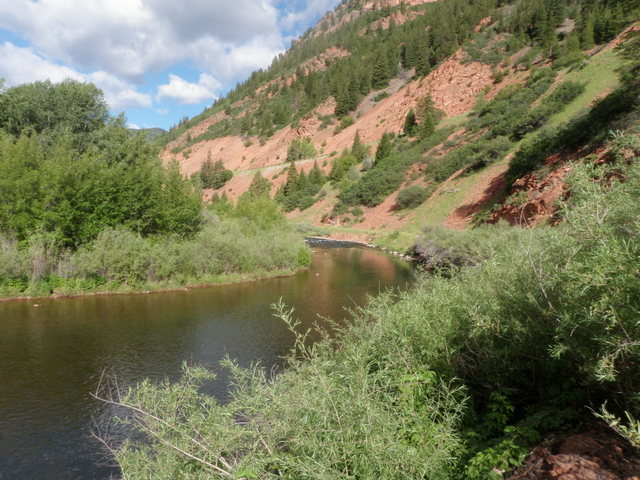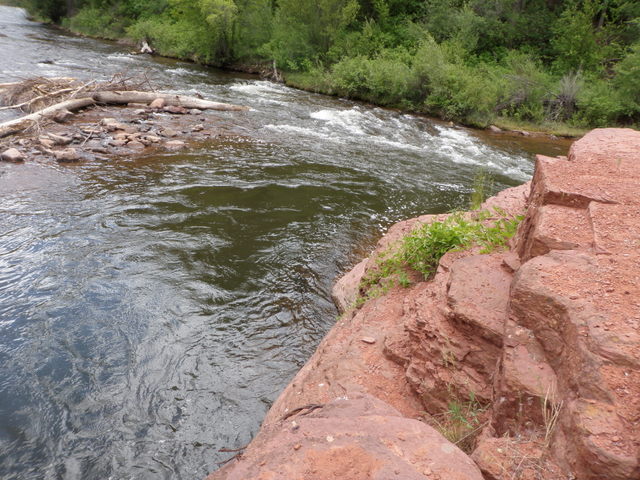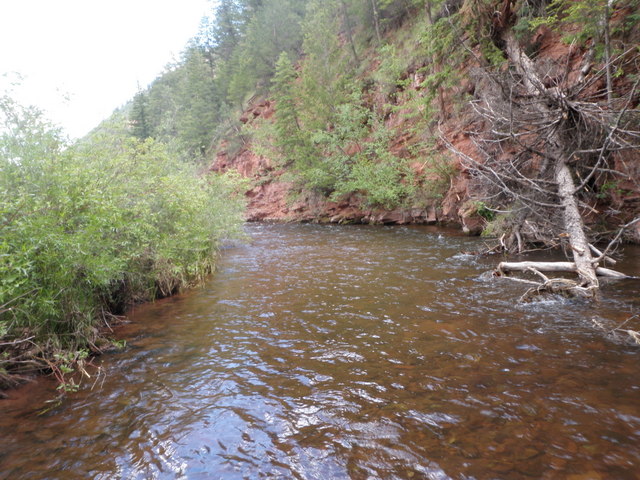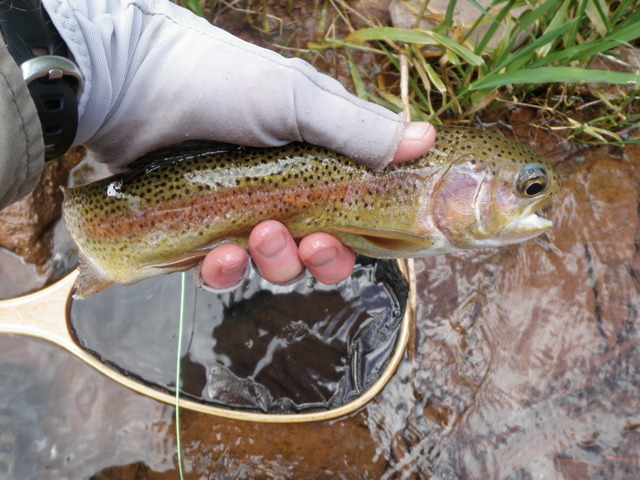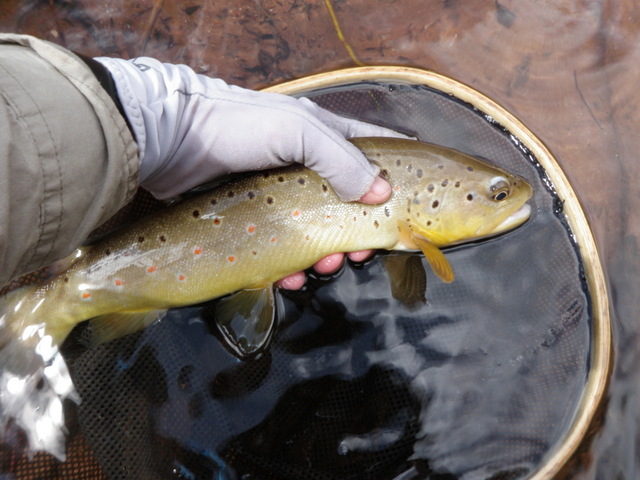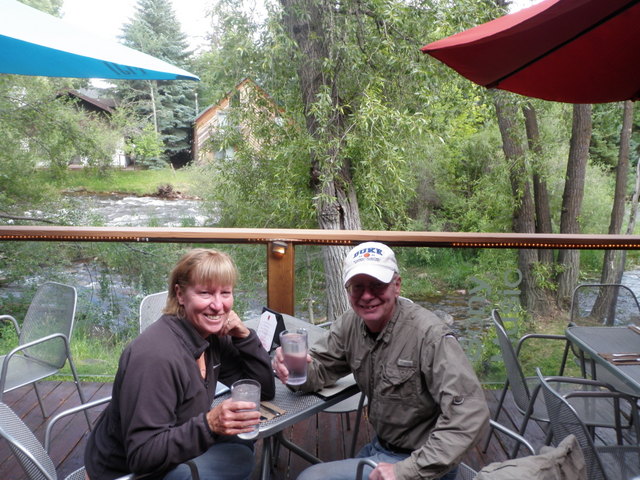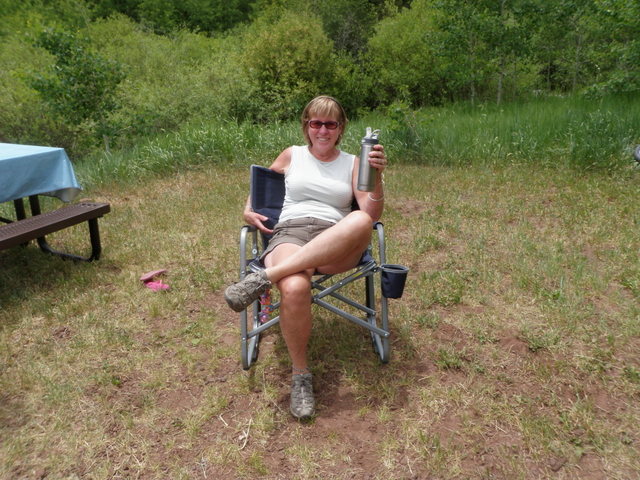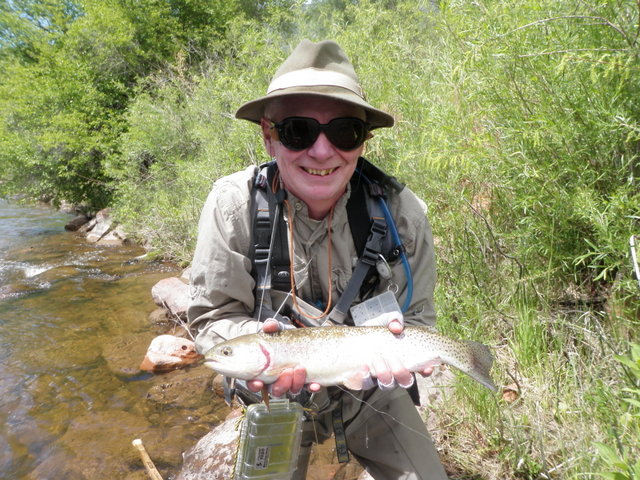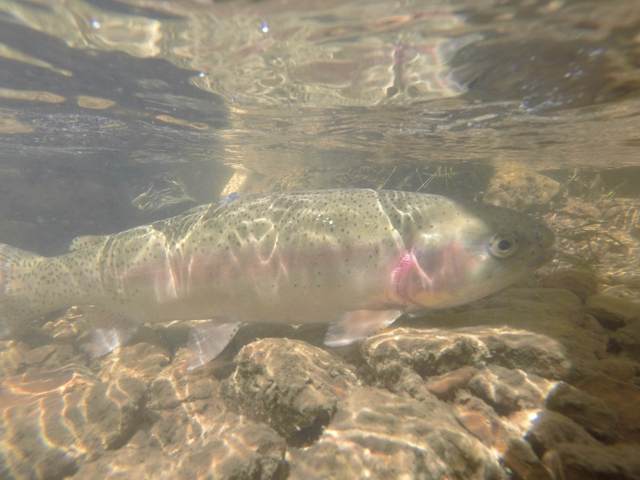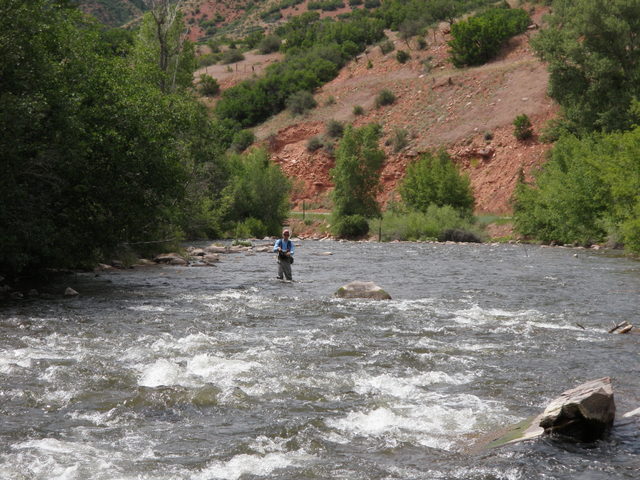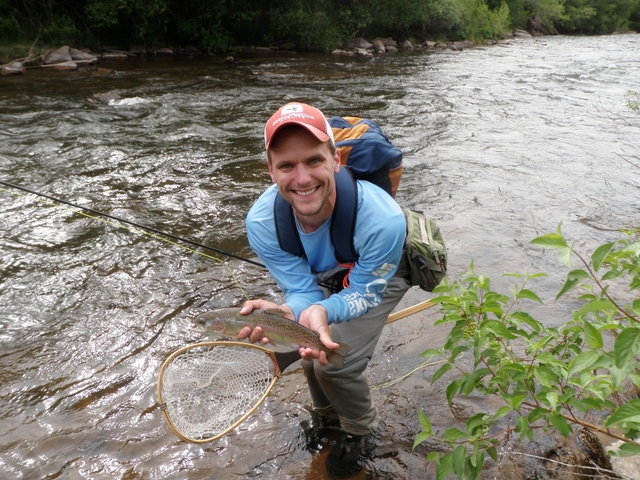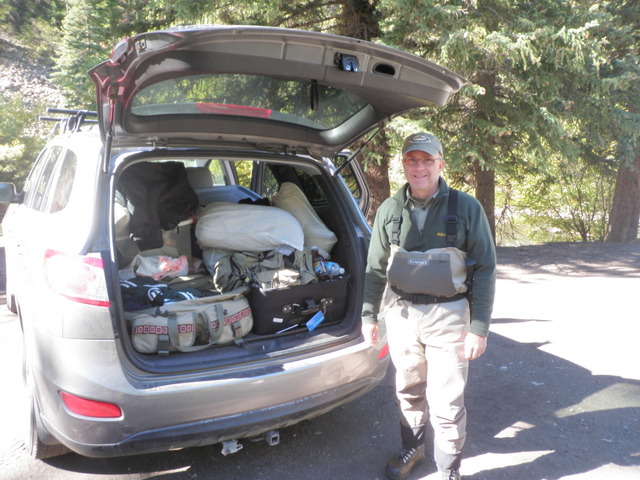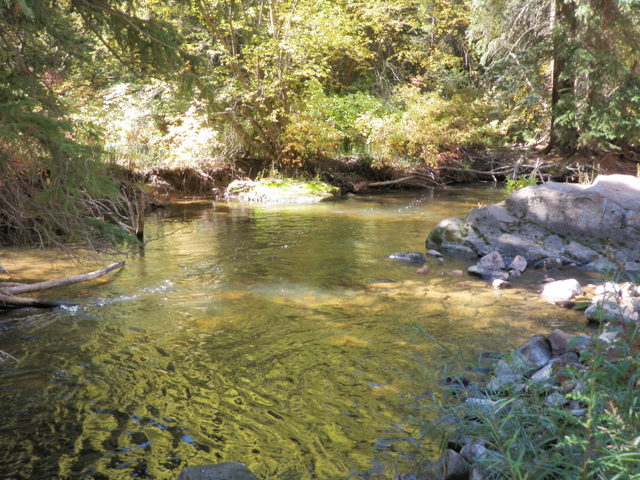Time: 10:00AM – 5:00PM
Location: Mainly around MM 11.75, but fished above MM12 from 4:30 until 5:00
Fish Landed: 12
Frying Pan River 09/15/2015 Photo Album
The middle of September, a weekday, and the Frying Pan River would certainly coalesce to provide another outstanding fishing experience on September 15. Or at least that was my thinking, as Jane and I packed the car to drive to Ruedi Reservoir on Monday morning. We drove separately so I could hike and camp with Jane on Monday at which point she would return to Denver on Tuesday leaving me to fish intensely on the Frying Pan River on Tuesday and Wednesday.
Backcountry Couple
We arrived at Little Maude Campground next to Ruedi Reservoir at around 12:30 on Monday, and then we quickly consumed our lunches and set out for a hike to Savage Lakes. The four mile round trip hike was a strenuous uphill for the first half and then a delightful downhill on the return, but it was well worth the effort, as Jane and I languished by the placid shores of Lower Savage Lake and soaked up the beauty. When we returned to our campsite we set up the tent, enjoyed some craft beers for happy hour, and then Jane prepared a tasty dinner of beans, rice and bratwursts. As we finished cleaning the dishes, we noticed some dark clouds building in the west, and we just managed to get situated in our sleeping bags in the tent before steady rain commenced.
The rain fluctuated between drizzle and a steady downpour, and when we woke up on Tuesday the campsite was a soggy mess. Rather than try to dry the tablecloth and picnic table to prepare breakfast, I suggested to Jane that we both drive to Basalt and find a breakfast spot. Jane was returning to Denver, so she transferred her necessary belongings to her car, and we were off. Breakfast was quite pleasant in the warm and dry confines of Cafe Bernard, and I savored a yogurt parfait topped with fruit and granola. This was an interesting twist on camping. After breakfast I said my goodbyes to Jane, and I drove back east along the Frying Pan River until I reached the wide shoulder parking space next to the spring half way between mile marker ten and eleven.
The weather continued to look quite threatening with huge gray clouds enveloping most of the sky, and it would remain this way for much of the day. The thick clouds resulted in high temperatures in the mid-60’s, and consequently I began my fishing day wearing my fleece and raincoat and New Zealand brimmed hat with ear flaps. The only time I shed layers was when I broke for lunch and returned to the campground from 12:15 until 12:45.
I Began Fishing Just Below the Tiny Island in the Center
By the time I was prepared to fish it was 10AM, and I selected my Sage four weight to probe the waters of the Frying Pan River. I walked downstream until I was just above the private water and began my day with a gray pool toy, salvation nymph, and an ultra zug bug. Within the first fifteen minutes I landed a nice twelve inch brown trout that snatched the salvation nymph as it drifted along a current seam. I was convinced that I was in for a memorable day of fishing.
A Pretty Fish to Begin My Day on the Frying Pan
I crossed to the side of the river away from the road and worked the edge pockets along the south bank. Several times in previous years I covered this section of the Frying Pan in the morning with positive results, but on Tuesday I could only manage two additional small brown trout. This was fairly disappointing since I was executing some expert backhand casts beneath the many overhanging tree limbs. The second fish was an interesting fish as it appeared to be a tiger trout with spots that were scrambled in a pattern quite different from the brown trout I usually land.
At eleven o’clock I completed a dicey crossing above the second island and hiked back along the shoulder to the Santa Fe. Since Jane and I left the campsite early for breakfast in Basalt, I needed to return to prepare lunch since all the food was stashed in the bear bin. By one o’clock I was back on the river, but this time I parked at the wide pullout above mile marker eleven. There was one other car parked a bit to the west, but I could not see the related fisherman, so I decided there was enough space to cover the bottom end of the upper four mile stretch of public water.
I grabbed my rod and walked westward until I was in the nice runs below deadfall pool. A huge dead tree spans the entire river from the bank along the road to the tip of an island thus the name deadfall. I could not interest any fish in my offerings below the tree, nor could I induce a take in the lower end of the pool created by the deadfall. As I was prospecting the pool with futility, I observed several rises and also spotted tiny size eighteen tan caddis dapping on the surface of the river. I did not really possess a matching fly, but I did experiment with a size 16 gray deer hair caddis with no response. The fish stopped rising so I returned to the dry/dropper arrangement but replaced the pool toy with a Chernobyl ant. I advanced upstream along the left bank, but once again my efforts were thwarted.
Next I encountered the span where the river flows around a host of tiny islands. In reality they are small clumps of grass, and in the past this area usually delivered several medium sized fish. On Tuesday I nabbed a small brown to take my fish count to six, but these fish were beneath the usual Frying Pan River trout from a size perspective. The nice pool below the large rock that hosts a tree appeared as my next fishing destination. I covered the area with the dry/dropper configuration and only attracted refusals in the form of subsurface inspections.
Periodically throughout the day some very thick clouds moved above me, and when this occurred, it provoked a flurry of dapping tan caddis. This in turn prompted a few sporadic rises from the observant fish in the river, and this circumstance reappeared at tree in rock pool. Once again I abandoned the dry/dropper approach and converted to a single dry fly. Unfortunately before I could thoroughly test the waters of the small pool, I executed a sloppy cast and actually hooked a branch from the tree growing out of the protruding rock, and this forced me to disturb the pool to retrieve my fly.
Cube Rock Pool
At this point I ascended the bank and passed my car and then cut through the woods and under some large evergreen trees to reach the area below the tip of the next island. I rounded the downstream point and worked up the right channel. This water is more conducive to dry/dropper as it displays numerous small deep pockets, so I once again made the conversion to the Chernobyl ant, hares ear, and salvation. I managed to increase my fish count to seven before I approached one of my favorite spots; cube rock pool. I paused to observe for a bit, but I saw no surface activity and resumed prospecting with the Chernobyl and generated another refusal.
Nestled in My Net
Once again the sky darkened, and the small tan caddis left their perches on the bushes and began their unruly surface antics, and this again provoked a few aggressive fish to rise. I did not have any caddis in the 18-20 size range nor did I possess any with a tan body, so I once again tried to improvise with a light gray size 16 deer hair imitation. Unlike my earlier attempt at this ruse, I did manage to at least create a few refusals. While this frustration was transpiring, a few PMD’s made an appearance, so I leaped at the opportunity to forsake the ineffective caddis, and knotted a size 16 light gray comparadun to my line. This made no difference, so I defaulted to a size 18 cinnamon comparadun tied specifically for the Frying Pan River.
I cast the small mayfly imitation upstream just below a large exposed rock where I could see a decent fish rising sporadically, and on the third drift I was rewarded with a confident slurp. I fought a very nice brown and brought it to my net. This was my best fish of the day so far, and the first that I was able to fool with a dry fly. Perhaps my luck was about to improve. Another fairly regular riser continued to work seven feet below the point where I hooked the nice brown, so I resumed drifting the cinnamon comparadun over this feeding lane. I stayed with this fish far too long, as it gave me hope by continually inspecting but not taking my fly until I finally conceded and moved to the pockets next to and above the tip of the island.
Held Up for Better Size Perspective
In one of the lower deep narrow pockets a rainbow appeared, and I was able to nick it momentarily with my comparadun. I was scrambling for success, so naturally I was quite upset that this fish evaded me. I persisted with some more casts in this small area, and I was surprised to see a small brown follow my fly downstream only to turn away as the fly dragged near the chute at the tail. I was not to be deterred, so I resumed popping casts to the very top, and eventually I hooked and landed a fat fourteen inch rainbow. Since the rainbow apparently had short memory and forgot the mayfly with a pointy tip, I worked the tail again and also nabbed the small brown. I generally move on quickly, but in this case it paid to dwell a bit.
I was now on a bit of a run with the cinnamon comparadun, and I moved to the pocket that takes the form of a deep curl shaped like a comma above the island. Here two fish were rising, so my pulse ticked up a beat. Unfortunately I managed only a long distance release on one fish, and the other stopped feeding. What should I do now? The river now morphed into a fast chute until mile marker twelve which was likely occupied with several fishermen. I climbed the bank and circled back down the road and carefully slid back to the base of the left braid. The left braid is smaller than the right and features a long difficult placid pool followed my some smaller pockets that occasionally produce nice fish. I was certain that the small cinnamon comparadun would attract interest in the long pool and the pockets at the top, but I was mistaken.
I once again climbed the steep bank and walked back to the car. It was now getting quite dark and the wind was escalating, so I stopped and pulled my fleece on under my raincoat. I walked along the shoulder a bit beyond my car and stopped to observe tree in rock pool from the road. Perhaps the cinnamon comparadun could produce where the caddis was ineffective? I gave it a try, but once again the pool defeated me. I decided to angle my way cautiously across the river to probe the angled riffle for the first time. I perched at the edge of the riffle and made some nice downstream drifts, but the fish were having none of it. By now I spotted a few small blue winged olives, so I switched to a size 20 parachute BWO, that I salvaged from a fly box that I found floating down the river on a previous trip. The BWO had a white wing post, but it was still difficult to follow in the dim light created by the dense late afternoon clouds and sun glare.
The BWO did not create interest, so I switched back to the cinnamon comparadun and worked my way to the top of angled riffle. Here in a nice deep trough next to some overhanging branches the small dun disappeared, and I hooked and quickly landed a feisty twelve inch brown. I continued upstream to inspect the nice pool across from the Santa Fe and again suffered a “look but no take” episode. I had already worked the right channel around the island, so I retreated back the way I came and crossed to tree in rock pool. I inspected the pool once again and spotted a fish that rose twice three feet below the rock.
Fifteen Inch Tail Wagger
The tan caddis were out again and doing their dance, so I tied on a size 16 gray caddis, but I had low expectations. I began making some excellent casts by checking high and allowing the caddis to flutter down, and on the fifth such action, a beautiful fifteen inch brown slowly moved up and sipped in my fly. What a thrill!
It was now getting late so I walked up the road beyond mile marker twelve to the nice stair step riffle segment below the large parking lot popular with the guides. This water was now open, so I cast there for a bit with no success, and then I checked out the nice hole next to the parking lot. I did spot a fish that rose twice in a deep small pocket behind a huge large square flat rock, but I was unable to create any interest from my caddis.
Hops Flowers Along the Frying Pan
It was a tough day on the Frying Pan River, and I was quite pleased to manufacture twelve fish. The hatches were very short and sparse, and that is unusual for the middle of September based on my past experience. Three of the last five fish that I landed were in the fourteen to fifteen inch size range, so this enabled me to end my day on an up note. Hopefully Wednesday will produce better results.

